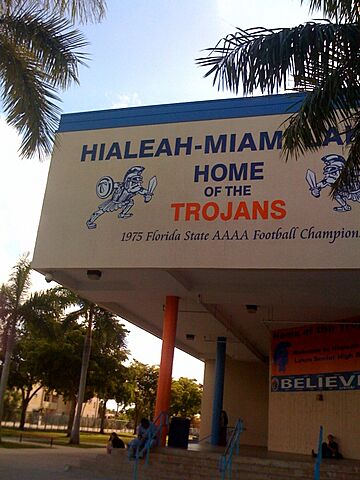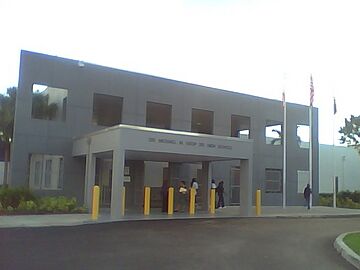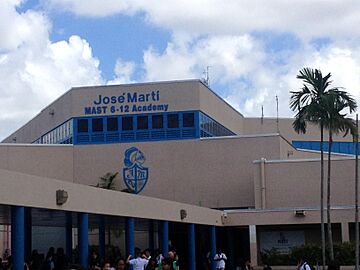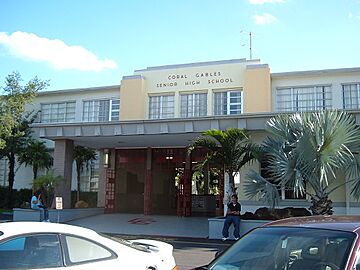Miami-Dade County Public Schools facts for kids
Quick facts for kids Miami-Dade County Public Schools |
|
|---|---|
 |
|
| Location | |
| 1450 NE 2nd Ave., Suite 912, Miami, Florida Florida United States |
|
| District information | |
| Type | Public |
| Motto | Giving our students the world. |
| Grades | Pre K-12 |
| Established | July 9, 1885 |
| Superintendent | Jose Dotres |
| Schools | 522 (2021-22) |
| Budget | $7 billion (2022-23) |
| District ID | 1200390 |
| Students and staff | |
| Students | 328,589 (2021-22) (4th-largest in U.S.) |
| Teachers | 17,365 (on a FTE basis) (2021-22) |
| Student-teacher ratio | 18.92 |
| Other information | |
| Teachers' unions | Florida Education Association |
| Website | dadeschools.net |
Miami-Dade County Public Schools (M-DCPS) is the public school system for Miami-Dade County in Florida, USA. It started in 1885 and is the largest school district in Florida. It's also one of the biggest in the entire United States.
This school district covers all of Miami-Dade County. A group called the School Board of Miami-Dade County manages it. They choose a superintendent to lead the daily operations. Currently, Dr. Jose Dotres is the Superintendent, a role he started in February 2022.
M-DCPS is special because it offers unique international studies and bilingual education programs. Students can learn in Spanish, French, German, Haitian Creole, and Mandarin Chinese. It's the only district in Florida with a Mandarin bilingual program.
Contents
History of Miami-Dade Schools


How it All Began (1800s)
The first meeting of the Board of Education for Dade County happened in Miami on June 27, 1885. The board members decided to divide the large county into four school areas. Miami became District #2, and Coconut Grove was District #3.
The First Coconut Grove School, built in 1887, was important for the early community. It served as both a church and a school. In 1889, the School Board rented the building for children in District #3. Some of the first students included the Peacock, Pent, and Frow families.
This historic schoolhouse is a simple, one-room wooden building. In 1970, it was moved to its current spot at the Plymouth Congregational Church. It was added to the National Register of Historic Places in 1975.
Growth and Challenges (1900s-1930s)
The early 1900s brought a lot of growth to Miami and its schools. By 1924, even after new counties like Broward and Palm Beach were formed, the school system still had 33 schools and almost 5,000 students.
A big challenge came with the 1926 Miami hurricane. Many schools were destroyed. This hurricane also ended Miami's land boom and led to tough times, even before the Great Depression hit in 1929. More schools had to close because of money problems.
In 1928, Miami Senior High, the district's first high school, moved to its current building. It cost over $1 million to build.
In 1926, the original Booker T. Washington Senior High School opened in Overtown. It was the only high school for Black students in South Florida at the time. Students came from many different counties to attend.
Mid-Century Changes (1940s-1970s)

World War II led to a population boom in Miami. Between 1945 and 1975, many new schools opened: 16 high schools, 30 middle schools, and 45 elementary schools.
In 1957, North Dade Jr./Sr. High School opened. It later became a junior high school. Also in this year, the school district created the Security Assistant position, which later became the Miami-Dade Public Schools Police Department.
On September 7, 1959, 25 African-American students started attending Orchard Villa Elementary and Air Base Elementary schools. This was a big step in ending segregation in the school system. By the end of that school year, almost half of the county's schools had started to desegregate. Parents could choose to send their children to any school if they had transportation. However, many schools didn't fully integrate until the late 1960s.
In 1961, the school system began a "Spanish for Spanish" program. With help from the Ford Foundation, this program grew into a full bilingual education curriculum. A pilot program at Coral Way Elementary School was very successful. This success helped lead to the Bilingual Education Act of 1968 across the U.S.
Starting in 1962, many Hispanic students, especially from Cuba, began enrolling in Dade County schools. This greatly shaped the school system into what it is today.
In 1975, school boundaries were set up. This meant students had to attend schools in their local areas. This rule allowed students to go to the closest school, no matter their race or background.
School populations grew in the 1960s and 70s. However, a teacher walk-out in the late 70s caused a temporary drop in student numbers. This helped with overcrowding and led to 11 schools closing. But students soon returned from private schools by the mid-1980s.
Modern Era (1980s-1990s)

In the 1980s, the school district was praised for helping new immigrant children, especially from Nicaragua, Haiti, and Cuba (after the Mariel Boatlift). It also handled students who were displaced after the 1982 Miami riot, which damaged 14 schools.
In 1986, the district started the first International Studies Magnet Program at Sunset Elementary School. This was one of the first such programs in the U.S. It won an award in 2008 for excellence in international education. The program offers a challenging curriculum in Spanish, French, and German, along with English. This program helps students become fluent in English and another language.
After Hurricane Andrew in 1992, Dade County was recognized for quickly rebuilding schools. Most schools reopened within two weeks. Students from destroyed schools were given free bus transportation to other schools. The district also used disaster funding to update its curriculum. They added sex education to elementary schools and foreign language programs to middle schools.
New magnet schools like Coral Reef High School and Southwood Middle School were opened. These schools accept students from all over the county based on their academic performance. Some magnet schools also enroll local students, while others only take students based on merit. The district also reopened Coral Way Elementary as its first bilingual school, teaching in both English and Spanish.
In 1996, the school board changed its structure to include more minority members. The number of board members increased from seven to nine, all elected from specific districts. This change doubled the number of Black members and quadrupled the number of Hispanic members. The board also started a program to create K-8 centers to reduce overcrowding in middle schools.
In 1997, Dade County officially changed its name to Miami-Dade County. The school board also changed its name to reflect this.
New Millennium (2000s-2010s)


The early 2000s saw a lot of new technology in classrooms. Teachers, students, and parents started using electronic gradebooks and educational software like BrainPOP. Later, Edmodo was also used in classrooms.
School overcrowding became an issue again in the early 2000s. Some high schools had over 4,500 students. To fix this, the school system began building and opening many new schools across the county.
In 2004, under new superintendent Dr. Rudy Crew, the school year started three weeks earlier. This helped the district match the rest of Florida and gave schools more time to prepare for the state's FCAT exam.
Schools that received a D or F grade on the FCAT were put on academic probation. The administration had three years to improve the school's grade to a C or higher. If not, serious actions could be taken, like changing staff or reducing funding for activities.
In 2008, Dr. Rudy Crew's contract was ended due to budget issues and his relationships with board members. Alberto Carvalho, a former science teacher in the district, replaced him.
After the 2010 Haiti earthquake, the district expected many survivors to enroll. However, fewer students arrived than predicted, and most were from middle and upper-class families. Miami-Dade County Public Schools enrolled the most earthquake survivors of any U.S. school district.
In the early 2010s, there was a greater focus on advanced education and magnet programs. New magnet schools and programs were created. Some existing schools, like HML's iPrep Academy, added magnet programs. Others, like José Martí Middle, became full magnet schools. In 2013, 100 new programs, including 49 iPrep Academies, were opened.
In 2013, Florida announced it would replace the FCAT with new PARCC exams. These exams were planned for the 2014–2015 school year. There were some concerns about the PARCC exams being longer and not yet fully developed.
Recent Events (2020s)
In 2023, a school in the Miami-Dade system, Bob Graham Education Center, removed the inaugural poem by Amanda Gorman from its curriculum. This happened after a parent complained, using new policies from Florida Governor Ron DeSantis.
School Leaders
- Rudy Crew (2004-2008)
- Alberto M. Carvalho (2008–2022)
- José L. Dotres (2022–present)
School Board Members
The School Board makes important decisions for the district. Here are the current members:
- Steve Gallon III – District 1
- Dorothy Bendross-Mindingall - District 2
- Lucia Baez-Geller – District 3
- Roberto J. Alonso – District 4
- Danny Espino – District 5 (Vice-Chair)
- Mari Tere Rojas – District 6 (Chair)
- Mary Blanco – District 7
- Monica Colucci – District 8
- Luisa Santos – District 9
Student Advisor to the School Board
The Student Advisor is chosen by the Miami-Dade County District Student Government Association. This student sits with the Board during meetings. They represent students and answer questions about student-related issues.
Student Population
As of August 30, 2016, Miami-Dade County Public Schools had 370,656 students.
Here's a breakdown of the students:
- Active students: 345,545
- Pre-K students: 6,931
- Part-time students: 476
- Current adult/vocational students: 17,124
- Co-enrolled in high school: 580
The district is known for having a large number of students from diverse backgrounds. In 2012, 62% of students were of Hispanic origin. 25% were Black, and 10% were Non-Hispanic White.
Many students speak a language other than English at home. In 2012, 54% spoke Spanish, and 5% spoke Haitian Creole. About 45% of students were in bilingual Spanish programs. Another 23% were in other bilingual programs, including French, German, Italian, Mandarin, Portuguese, and Haitian Creole.
Schools in Miami-Dade

Most new schools are named after people who worked for or were involved with M-DCPS. The district allows schools to be named after people who are still alive.
Top Ranked Schools
Several Miami-Dade County Public Schools high schools have been recognized nationally for their excellence.
U.S. News & World Report Rankings
Here are some M-DCPS high schools ranked among the best in the U.S. by U.S. News & World Report:
| National Ranking | Top Public High Schools in the United States | |||
| 2012 | 2009 | School | Location | |
|---|---|---|---|---|
| 16 | 15 | Design and Architecture Senior High School (DASH) | Design District, Miami | |
| 26 | NR | Young Women's Preparatory Academy | Little Havana, Miami | |
| 50 | NR | International Studies Charter High School | Little Havana, Miami | |
| 73 | 66 | Maritime and Science Tech High School (MAST) | Virginia Key, Miami | |
| 131 | 95 | Coral Reef Senior High School | Richmond Heights, Unincorporated Miami-Dade County | |
| 183 | NR | Doral Performing Arts and Entertainment Academy | Doral | |
| 186 | 82 | New World School of the Arts | Downtown, Miami | |
Here are some M-DCPS high schools ranked among the best in Florida:
| Florida Ranking | Top Public High Schools in Florida | |
| 2012 | School | Location |
|---|---|---|
| 1 | Design and Architecture Senior High School (DASH) | Design District, Miami |
| 2 | Young Women's Preparatory Academy | Little Havana, Miami |
| 7 | International Studies Charter High School | Little Havana, Miami |
| 11 | Maritime and Science Tech High School (MAST) | Virginia Key, Miami |
| 15 | Coral Reef Senior High School | Richmond Heights, Unincorporated Miami-Dade County |
| 16 | Doral Performing Arts and Entertainment Academy | Doral |
| 17 | New World School of the Arts | Downtown Miami |
| 28 | Miami Beach Senior High School | South Beach, Miami Beach |
| 43 | Mater Academy East High School | Little Havana, Miami |
| 47 | Doral Academy High School | Doral |
Newsweek Rankings
In 2011, Newsweek ranked several MDCPS schools among the 500 Best High Schools in America:
| National Ranking | School | Location |
|---|---|---|
| 28. (4th in Florida) | School for Advanced Studies | North, South, Wolfson and Homestead campuses, at Miami Dade College, Miami-Dade County |
| 46. (7th in Florida) | Maritime and Science Tech High School (MAST) | Virginia Key, Miami |
| 53. | Coral Reef Senior High School | Richmond Heights, Unincorporated Miami-Dade County |
| 251. | Miami Palmetto Senior High School | Pinecrest |
| 374. | Doctors Charter School of Miami Shores | Miami Shores |
| 404. | Mater Academy Charter School | Hialeah Gardens |
| 427. | Mater Academy Lakes High School | Unincorporated Miami-Dade County |
| 456. | Doral Academy Charter High School | Doral |
Broadcasting Stations
MDCPS runs its own TV and radio stations. These include WLRN-TV (Channel 17), which is a PBS television station, and WLRN-FM (91.3 FM), an NPR radio station.
Notable Employees
- Tombi Bell (1979–): A former basketball player for the Florida Gators and the Minnesota Lynx. As of 2013, she taught physical education at José Martí MAST 6-12 Academy.
- Jay W. Jensen (1931–2007): Taught drama at Miami Beach Senior High School for 32 years. His students included famous actors like Mickey Rourke and Andy Garcia. He also appeared in many films himself.
- Lizbet Martinez (1982-): As of 2013, she taught music and language arts at the M.A. Milam K-8 Center. She became famous in 1994 for playing "The Star-Spangled Banner" on her violin after being rescued at sea by the U.S. Coast Guard.
- Bertha Vazquez (1990-): Teaches science at G. W. Carver Middle School. She also directs the Teacher Institute for Evolutionary Science.
See also
 In Spanish: Escuelas Públicas del Condado de Miami-Dade para niños
In Spanish: Escuelas Públicas del Condado de Miami-Dade para niños
- Education in Florida
- Broward County Public Schools

